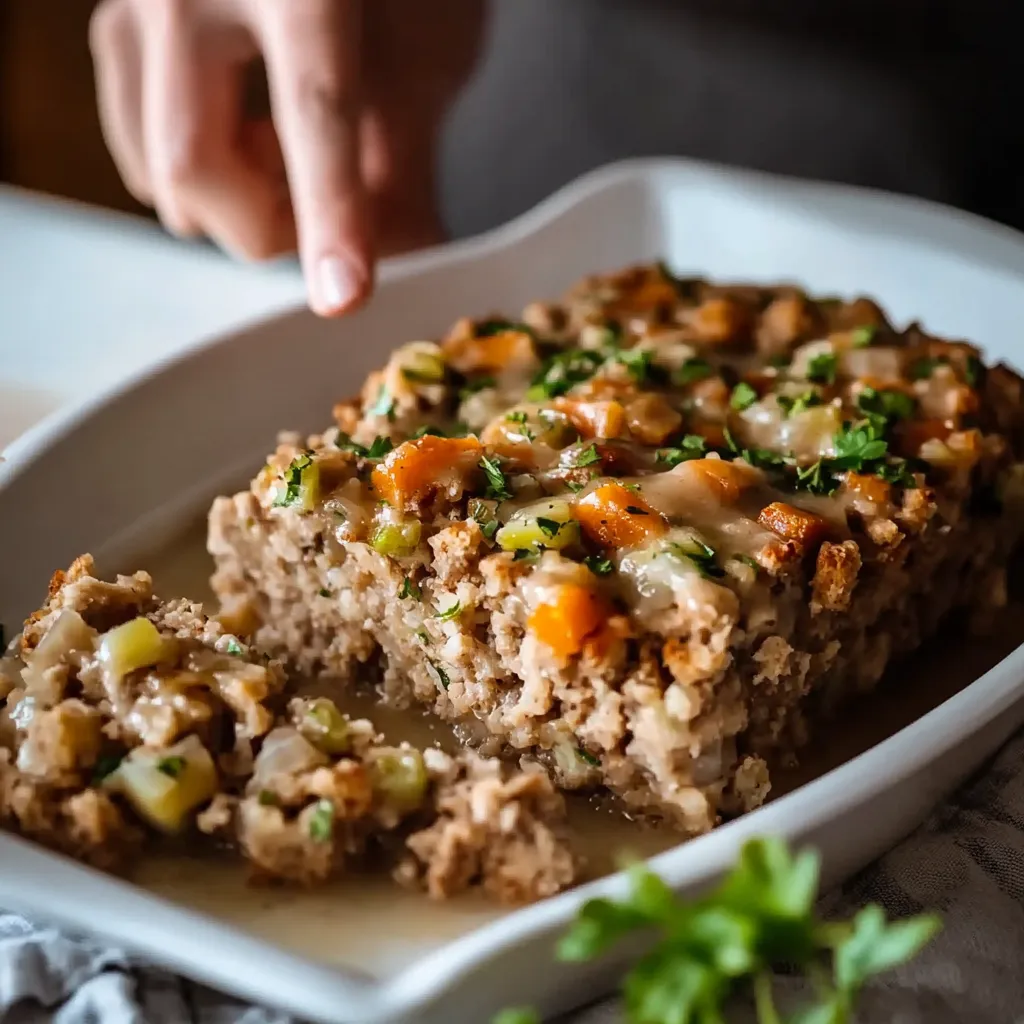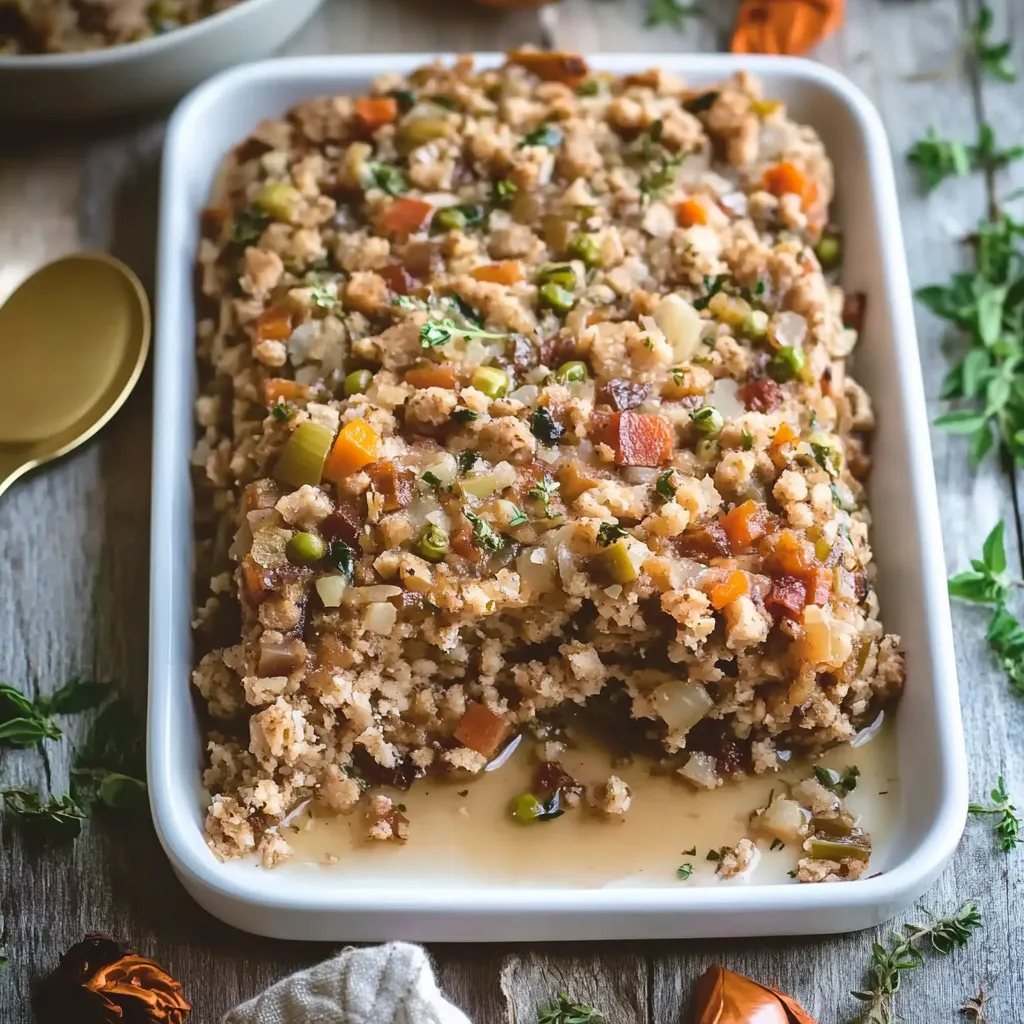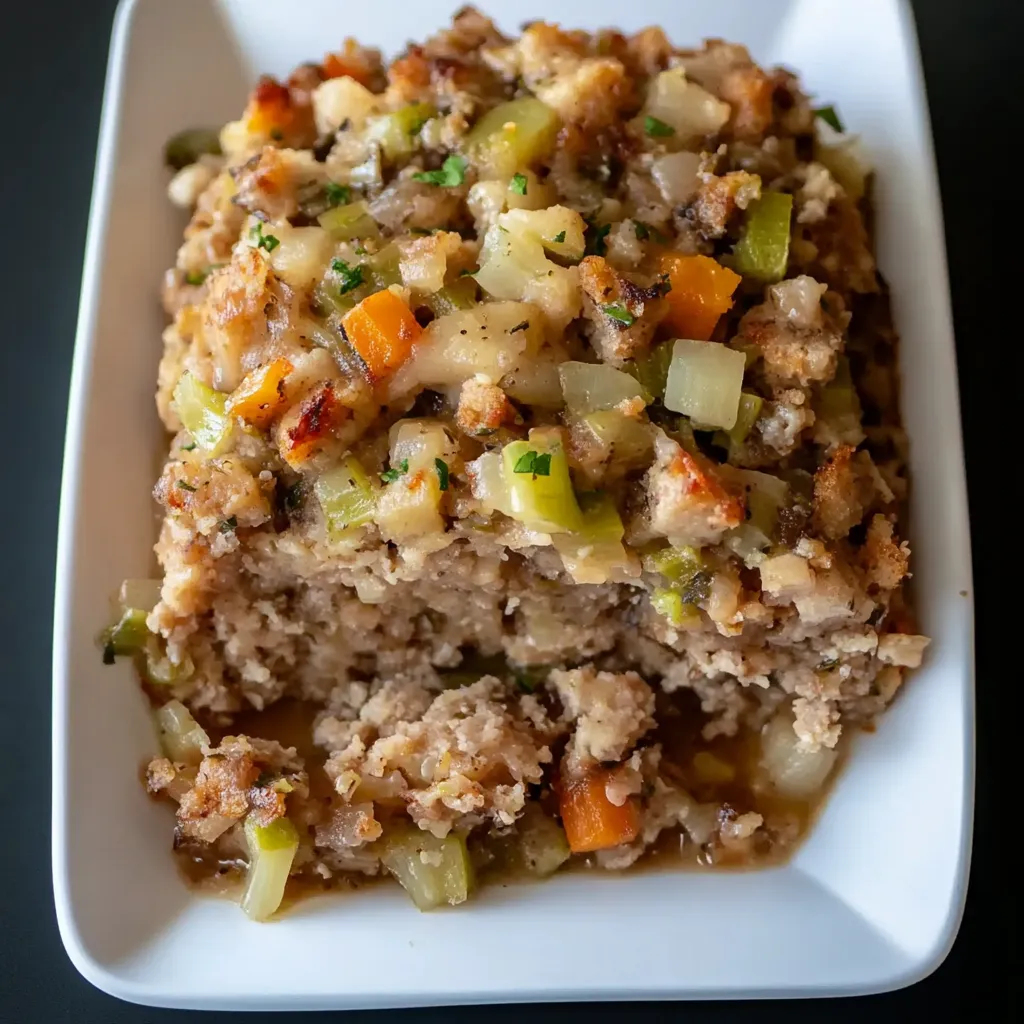Thanksgiving is about much more than just turkey; it’s a time to come together and enjoy a hearty meal that includes some beloved side dishes. And among all the options, Homemade Turkey Stuffing is a timeless classic that no Thanksgiving table should be without. Whether you’re preparing it for a family gathering or a cozy dinner, this dish adds both flavor and warmth to the occasion.
But let’s be honest—many people use boxed stuffing mixes to save time, and while that’s okay, nothing compares to the rich, savory taste of a homemade version. This recipe will guide you through making Homemade Turkey Stuffing from scratch, and the result will be an unforgettable dish that stands out at the table.

Why Homemade Turkey Stuffing?
Before we dive into the recipe, let’s take a moment to consider why homemade stuffing is worth the extra effort. Here are just a few reasons why you should skip the boxed stuff and make Homemade Turkey Stuffing instead:
-
Customizable to Your Taste: You control the ingredients and can add things like sausage, cranberries, or different herbs based on your preferences.
-
Fresh Ingredients: Homemade stuffing uses fresh bread, herbs, and broth, making it more flavorful and aromatic.
-
No Artificial Additives: Unlike pre-packaged stuffing mixes, homemade stuffing doesn’t contain preservatives or artificial flavors, making it a healthier choice.
-
Increased Moisture and Texture: By using the right bread and adding broth, you can ensure that your stuffing has the perfect balance of crispiness and moisture.
So, let’s get started with your Homemade Turkey Stuffing!

Ingredients for Homemade Turkey Stuffing
When making Homemade Turkey Stuffing, the ingredients you choose will play a huge role in determining the final flavor and texture. Here’s a list of what you’ll need:
-
Bread: The foundation of any good stuffing is bread. For the best texture, use a dense bread like French bread, sourdough, or even cornbread. These types of bread hold up well when soaked in broth.
-
Tip: Stale bread works best as it won’t turn mushy when mixed with liquid.
-
-
Butter: Adds richness and moisture to the stuffing while also helping to sauté the vegetables.
-
Vegetables: Celery and onions are the traditional choices. They provide an aromatic base and a nice crunch.
-
Herbs: Fresh rosemary, sage, and thyme are classic herbs for Homemade Turkey Stuffing. These herbs impart a wonderful fragrance and earthy flavor.
-
Chicken Broth (or Turkey Broth): This is what brings the stuffing together and keeps it moist. You can use turkey broth for a deeper flavor, but chicken broth works just as well.
-
Seasonings: Salt and pepper are essential to bring out all the flavors in the stuffing.
Optional Add-ins:
-
Sausage: For a meaty version of your stuffing, add crumbled sausage. It adds richness and depth.
-
Nuts: Walnuts, pecans, or hazelnuts provide a delightful crunch.
-
Cranberries: For a hint of sweetness and color, dried cranberries make a great addition.
-
Apples: Adds a subtle sweetness and pairs perfectly with the savory flavors.
Step-by-Step Guide to Making Homemade Turkey Stuffing
Now that you have all the ingredients ready, let’s dive into the process of making Homemade Turkey Stuffing. This is a simple, straightforward method that will ensure your stuffing turns out perfectly every time.
Step 1: Prepare the Bread
For the best Homemade Turkey Stuffing, it’s important to start with the right bread. As mentioned earlier, stale or dried bread works best because it absorbs the broth without turning mushy.
-
Cut the Bread into Cubes – Begin by slicing your bread into 1-inch cubes. If you’re using store-bought bread, aim for bread with a dense texture, like sourdough, French bread, or even challah.
-
Dry Out the Bread – Spread the cubed bread on a baking sheet and bake at 300°F for about 15 minutes, or until the bread is slightly toasted. This will help the bread hold its shape and not turn soggy when you add the liquid.
-
Let the Bread Cool – After baking, allow the bread cubes to cool on the baking sheet. This step is crucial as it prevents the bread from becoming too soft once you add the liquid.
Step 2: Sauté the Vegetables
The next step is to sauté the vegetables to bring out their flavor. This will form the aromatic base of your Homemade Turkey Stuffing.
-
Melt the Butter – In a large skillet or saucepan, melt 1 ¼ cups of butter over medium-high heat. Butter adds richness and flavor to the stuffing, so don’t be afraid to use it generously.
-
Cook the Celery and Onions – Add 1 cup of chopped celery and 1 ½ cups of chopped onion to the pan. Sauté them for about 5 minutes, or until the onions are translucent and the celery is softened. This will release their flavors and make the stuffing aromatic.
-
Season – Add salt and pepper to taste. This is the time to season your vegetables, so make sure they’re well-seasoned before proceeding to the next step.

Step 3: Combine with Broth and Herbs
After the vegetables are sautéed, it’s time to introduce the broth and herbs, which will help bring everything together.
-
Add the Broth – Pour in 3 ½ cups of low-sodium chicken or turkey broth. Stir the mixture and bring it to a simmer over medium heat. Let it cook for a couple of minutes to allow the flavors to come together.
-
Add Fresh Herbs – Toss in 1 tablespoon of chopped fresh rosemary and 1 tablespoon of chopped fresh sage. These herbs are key to the flavor profile of your Homemade Turkey Stuffing. If fresh herbs aren’t available, you can substitute dried herbs, but reduce the quantity by half.
-
Let the Mixture Simmer – Allow the mixture to simmer for 2-3 minutes. This allows the broth to become infused with the flavor of the vegetables and herbs, creating a fragrant liquid to soak into the bread.
Step 4: Combine Bread and Broth Mixture
Once the broth and vegetables have been seasoned and flavored, it’s time to bring in the bread.
-
Add the Bread – Gradually add the toasted bread cubes to the broth and vegetable mixture, stirring gently. You want the bread to absorb the flavorful liquid without becoming too soggy. Stir carefully to coat the bread evenly.
-
Let it Rest – After mixing the bread with the broth, let it sit for 5 minutes. This gives the bread time to absorb the liquid and soften, but not to the point of becoming mushy.
Step 5: Bake the Stuffing
The final step is baking your Homemade Turkey Stuffing to perfection. This is what will give the stuffing its crispy top and allow all the flavors to meld together.
-
Prepare the Baking Dish – Grease a 9×13-inch baking dish with cooking spray or a light coating of butter.
-
Transfer the Mixture – Spoon the bread and broth mixture into the prepared baking dish, spreading it evenly.
-
Cover and Bake – Cover the dish with aluminum foil and place it in a preheated 350°F oven. Bake for 30 minutes. The foil helps to trap moisture inside, ensuring your stuffing cooks evenly.
-
Crisp the Top – After 30 minutes, remove the foil and switch your oven to broil (on low). Allow the stuffing to bake for an additional 5 minutes, or until the top is golden brown and slightly crispy. You can also bake for another 5-10 minutes at 350°F if you prefer not to use the broiler.
Step 6: Let It Cool and Serve
Once your Homemade Turkey Stuffing is golden and crispy on top, it’s ready to be served. Let it cool for a few minutes before serving to allow it to firm up slightly.
This stuffing pairs beautifully with turkey, mashed potatoes, and all your other Thanksgiving favorites.
This step-by-step guide ensures that your Homemade Turkey Stuffing will be delicious and perfectly textured. The combination of toasted bread, savory vegetables, and fresh herbs makes this dish a crowd-pleaser every time.
Tips and Variations for Your Homemade Turkey Stuffing
While the recipe above gives you a fantastic, classic Homemade Turkey Stuffing, there are several ways to make this dish uniquely yours. By adding a few twists and variations, you can adapt this stuffing recipe to suit your tastes or dietary needs. Here are some helpful tips and ideas for customizing your Homemade Turkey Stuffing.
Make It Ahead of Time
One of the best things about Homemade Turkey Stuffing is that it can be prepared in advance, saving you time on the big day.
-
Assemble the Stuffing – You can prepare everything up to the point where the stuffing goes into the oven. Once it’s mixed and in the baking dish, cover it with aluminum foil and refrigerate for up to 48 hours before baking.
-
Bake When Ready – When you’re ready to cook, remove the stuffing from the fridge and let it sit at room temperature for about 30 minutes. Then, proceed with baking as usual.
If you’re making stuffing for a larger crowd, making it ahead of time allows you to focus on other dishes while still serving up a homemade treat.
Can You Freeze Homemade Turkey Stuffing?
Yes! You can freeze your Homemade Turkey Stuffing for up to 3 months. Here’s how to do it:
-
Cool Completely – Allow the stuffing to cool completely before freezing to prevent moisture buildup.
-
Freeze – Place the cooled stuffing in an airtight container or freezer-safe zip-lock bags. Make sure to press out any excess air to prevent freezer burn.
-
Reheat – To reheat, thaw in the refrigerator overnight. Then, bake in the oven at 350°F for about 20 minutes or until heated through. You can also add a small amount of broth to the stuffing before reheating to ensure it stays moist.
Common Stuffing Add-Ins
If you want to get creative with your Homemade Turkey Stuffing, here are some fun variations you can try:
-
Sausage: Adding crumbled cooked sausage gives the stuffing a hearty, savory flavor.
-
Nuts: Walnuts, pecans, or almonds add a delightful crunch and a rich flavor.
-
Dried Fruit: Dried cranberries, raisins, or apricots bring a touch of sweetness that balances the savory elements.
-
Vegetarian Options: If you’re making a vegetarian stuffing, simply swap the chicken or turkey broth for vegetable broth and skip the sausage.
-
Mushrooms: For an earthy, umami flavor, sautéed mushrooms are an excellent addition to your stuffing.
The Difference Between Stuffing and Dressing
You may have noticed that some people refer to this dish as “dressing” instead of stuffing. The main difference comes down to the method of cooking:
-
Stuffing is typically cooked inside the turkey cavity, absorbing all the rich flavors from the bird.
-
Dressing, on the other hand, is cooked separately, usually in a baking dish, as in this recipe.
Different regions of the U.S. use different terminology, with people in the Northeast often calling it “stuffing” and those in the South typically calling it “dressing.” But regardless of what you call it, this recipe for Homemade Turkey Stuffing will be the star of the meal!
Serving Suggestions
Homemade Turkey Stuffing is the perfect complement to many Thanksgiving dishes. Here are a few ideas for what to serve alongside it:
-
Roast Turkey: The classic pairing for stuffing, especially if the stuffing is cooked inside the turkey.
-
Mashed Potatoes: Creamy mashed potatoes are a must alongside stuffing, especially with a rich gravy.
-
Cranberry Sauce: The tartness of cranberry sauce pairs wonderfully with the savory stuffing.
-
Roasted Vegetables: Carrots, Brussels sprouts, or sweet potatoes bring a touch of sweetness and color to your plate.
Final Thoughts Homemade Turkey Stuffing Recipe
Making Homemade Turkey Stuffing from scratch is a rewarding experience that results in a dish full of flavor, texture, and heart. It’s a perfect side dish for Thanksgiving, holiday dinners, or any special occasion. With this recipe, you have the flexibility to adapt it to your preferences, whether that means adding sausage, nuts, or making it ahead of time to save precious cooking hours.
Remember, the key to the best stuffing is using quality, fresh ingredients. From the herbs to the broth, every element of this dish adds to its depth of flavor. Don’t be afraid to experiment with variations and find the perfect combination for your family’s taste.
With this easy-to-follow guide, you’ll be able to create Homemade Turkey Stuffing that will become a beloved tradition at your holiday table for years to come. Whether you’re serving it alongside a juicy turkey or as a stand-alone side, this stuffing will surely win over your guests and become the highlight of your meal.

Homemade Turkey Stuffing Recipe Card
Ingredients:
-
1 ¼ cups butter
-
1 cup chopped celery
-
1 ½ cups chopped onion
-
3 ½ cups low-sodium chicken broth (or turkey broth)
-
18 ounces bread (French bread, sourdough, or cornbread), cubed and dried
-
1 tablespoon fresh rosemary, chopped
-
1 tablespoon fresh sage, chopped
-
Salt and black pepper to taste
-
Optional add-ins: Crumbled sausage, nuts (e.g., walnuts, pecans), dried cranberries, apples
Instructions:
-
Prepare the Bread: Cube the bread into 1-inch pieces and spread on a baking sheet. Bake at 300°F for 15 minutes or until the bread is lightly toasted. Let it cool.
-
Sauté Vegetables: In a large skillet, melt butter over medium-high heat. Add chopped celery and onions, and sauté for about 5 minutes until softened. Season with salt and pepper.
-
Add Broth and Herbs: Pour in chicken or turkey broth and bring to a simmer. Stir in rosemary and sage. Let the mixture simmer for 2-3 minutes.
-
Combine Bread and Broth: Add the toasted bread cubes into the skillet, stirring gently to coat with the broth mixture. Let it rest for 5 minutes to allow the bread to absorb the liquid.
-
Bake: Transfer the bread mixture into a greased 9×13-inch baking dish. Cover with foil and bake at 350°F for 30 minutes. Remove foil and broil for 3-5 minutes until the top is golden brown and crispy.
-
Serve: Allow the stuffing to cool for a few minutes before serving.
Notes:
-
Make Ahead: You can prepare the stuffing up to 48 hours in advance. Cover and refrigerate before baking.
-
Freezing: Freeze leftovers for up to 3 months. Thaw overnight in the fridge and reheat in the oven at 350°F for 15-20 minutes.
-
Optional Add-ins: Enhance the stuffing by adding crumbled sausage, chopped nuts, or dried fruits like cranberries for extra texture and flavor.
Nutritional Facts (Per Serving):
-
Calories: 426 kcal
-
Carbohydrates: 43g
-
Protein: 8g
-
Fat: 25g
-
Saturated Fat: 15g
-
Polyunsaturated Fat: 1g
-
Monounsaturated Fat: 7g
-
Trans Fat: 1g
-
Cholesterol: 62mg
-
Sodium: 933mg
-
Potassium: 269mg
-
Fiber: 2g
-
Sugar: 5g
-
Vitamin A: 762 IU
-
Vitamin C: 2mg
-
Calcium: 76mg
-
Iron: 2mg
Prep Time: 20 minutes
Cook Time: 35 minutes
Total Time: 55 minutes
Method: Baking
Cuisine: American
Servings: 8
Calories: 426 per serving
Yield: 8 servings
